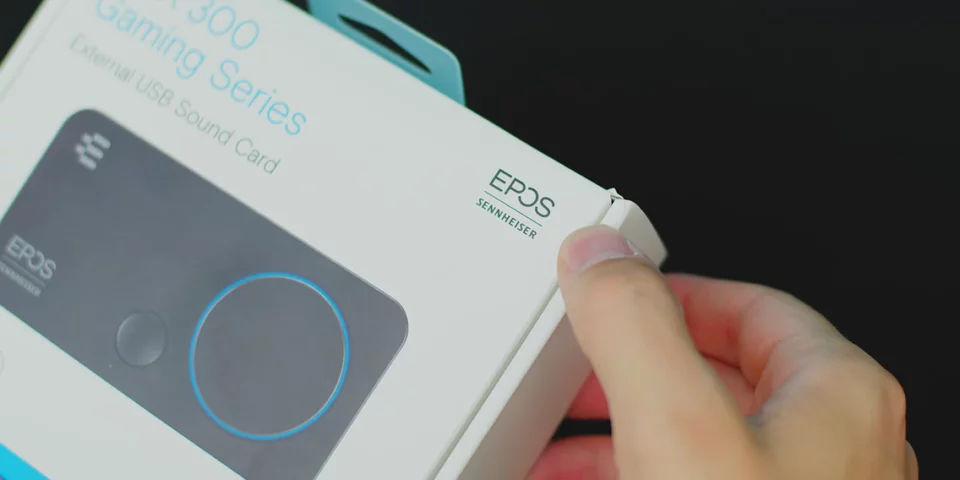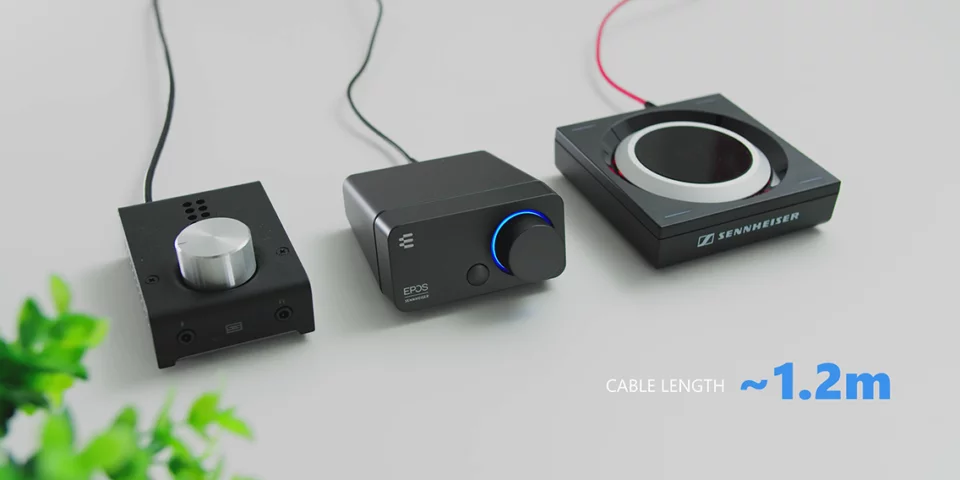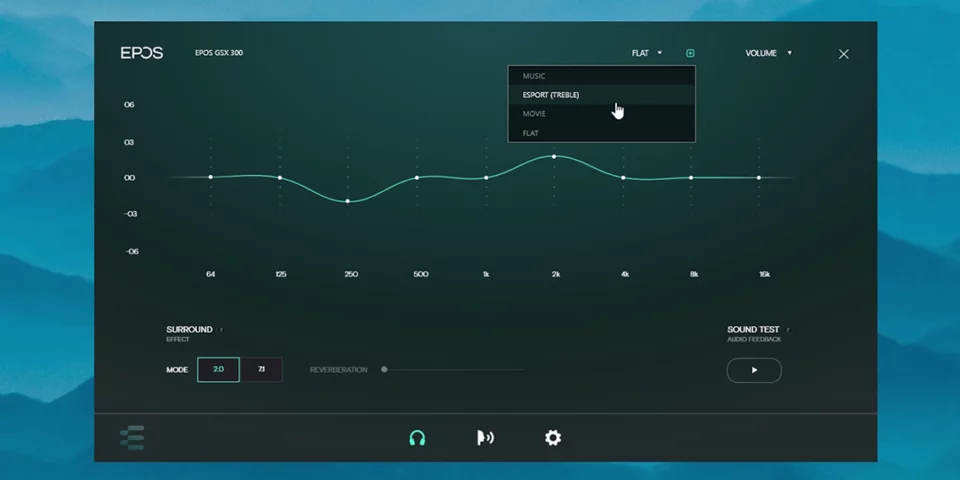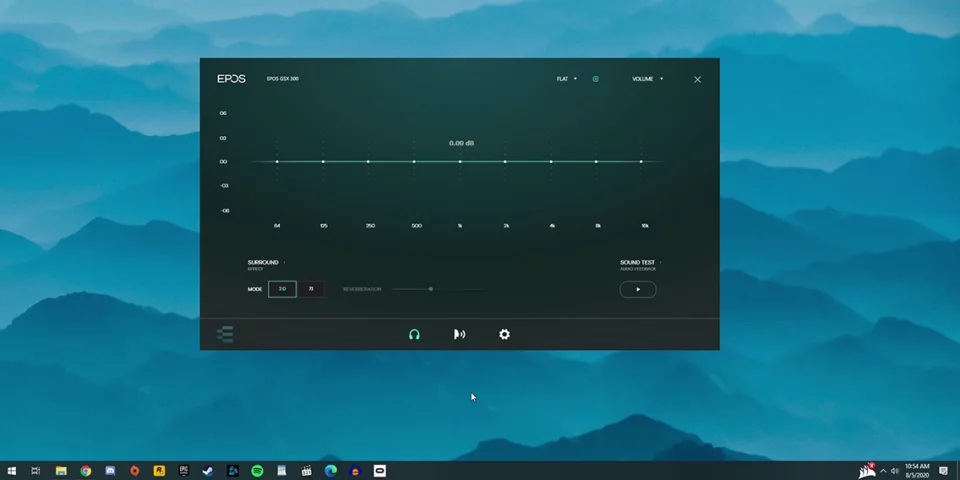Sennheiser Has LEFT The Chat – EPOS GSX 300 Gaming DAC Review

Share:
Today we are checking out the new EPOS GSX 300 gaming DAC. Now you might be wondering what the heck EPOS is, and that confusion is normal at the moment because it is a brand new moniker. In order to separate their gaming products from their regular audio products, Sennheiser has decided to launch all their gaming-related products under the new EPOS umbrella.
Just a few clarifications, it’s not like a separate brand that bought Sennheiser, it’s a different division within Sennheiser that is separated and is now EPOS. All existing gaming products from Sennheiser have the EPOS/Sennheiser branding, while moving forward whenever they release new products it will just be EPOS.
All existing products will carry over the exact same technologies and designs that have been developed by Sennheiser, just under a different brand name. I think it will take some time for EPOS to gain some popularity and brand loyalty, because the Sennheiser logo is instantly recognizable and immediately adds value, while EPOS doesn’t really.
Price & Competition
In this review we are going to talk about the GSX 300, the new external USB sound card from EPOS. I will be comparing it to the GSX 1000, because that was the original and it’s still one of the best surround sound USB sound cards on the market. We will also compare it to the Schiit Fulla 3, which is a $99 DAC/Amp combo also geared towards gamers because of that mic input. I really hope that EPOS will be able to fix all the driver and software issues that I’ve experienced with Sennheiser products in the past, and I’m hoping we don’t have any in this review.
First of all, I would say that buying an external USB sound card for gaming is not necessary in 2020, because most motherboards have really good audio amplification and pretty decent microphone quality as well. I have done extensive audio and microphone testing to confirm the capabilities of different motherboards and external solutions. Having said that, the reason you might want to pick this up is for convenience, for example using this with a notebook or if you are moving computers and you want to still carry over the same audio that you are used to a gaming DAC is a good option.
Build & Design
In terms of physical characteristics, it is a fairly small unit available in black or white, but the black model I have is not exactly black, more like gunmetal grey. There are some rubber pads at the bottom, and the unit is angled to kind of face you, which is nice. At the front there is volume wheel with beautiful tactile steps, so you can control exactly how much volume you are adding or removing. It is not a button, so you cannot press it to mute. Beside it is a button that can either enable surround sound mode or switch between presets. At the back there is a micro-USB connection and headphone and microphone inputs. The volume adjustment is instantaneous without any delay, and the only way to mute it is to go all the way down. Overall, it’s a really simple and basic USB sound card, and the one thing they all share between the Fulla 3, the GSX 1000, and the GSX 300 is a really short USB cable. If I plug this into my machine I don’t have much flexibility on where to position it on my desk.
Features
What I’m really interested in is really hearing the difference between the Schiit Fulla 3, the GSX 1000, and this new GSX 300 in terms of power output, clarity, soundstage delivery, and the overall character of the audio. I’m also really interested to hear what the surround sound implementation is like on the GSX 300 since it is so much cheaper than the GSX 1000, which has an incredible binaural engine built-in. We will see if any of that carries over.
The GSX 300 is the only one that has any software included, because GSX 1000 has all the controls on the app actual unit, while the Fulla 3 is completely driverless. Inside the gaming suite, we have all the usual EQ customization and profiles, lots of microphone controls, and the only thing you can map to the front-mounted smart button is changing your profiles or enabling/disabling surround sound. I really wish that you could map it to mute as well.
Power Output & Sound Quality
Let’s begin with the power comparison using the Sennheiser GSP 300, a fantastic $99 headset. It’s a 19 ohm device at 113dB sensitivity, so you don’t require too much power to drive this thing. With the Fulla 3 at 60% volume I’m more than comfortable driving this with beautiful low-end tones and overall smooth presentation. Moving on to the GSX 300, and this thing requires almost 100% volume to drive this headset properly. There are audible crackles when you change the volume, so like each step has kind of like a ticking noise. It’s not distracting, and it’s only present when you are changing volume. The one advantage of the GSX 300 is that it delivers a fuller sound versus the Fulla 3, and it has better stereo imaging giving you slightly wider soundstage in a default mode, not even enabling the 7.1 surround sound. As for the GSX 1000, this thing is slightly more powerful at 70% volume I’m comfortable volume-wise. It is more powerful than the GSX 300, but they share very similar sound characteristics, nice beautiful body and low-end, not too sharp on the high-end, and a slightly wider soundstage than the Fulla 3.
Moving up to higher-end headphones, we have the Sennheiser HD 58X. These things are incredible sound wise, built quality wise, value wise, and they clock in at 150 ohms and 104dB sensitivity. Using them with the GSX 300 wasn’t perfect, more volume was desired just because it’s an open headset, so you do eventually kind of lose out on some of the detail. You want to crank up the volume in order to maintain everything in the headphone, but there is still great tones and good detail even at 100% volume. The GSX 1000 is slightly more powerful, so at 70% volume it’s about the equivalent to what you get at 100% with the GSX 300. To my ears the GSX 1000 also has more soundstage pickup, especially when you are listening to live recordings. It’s like your ears are there instead of the microphone. The Fulla 3 is of course is a lot more powerful, so it has no problem driving the HD 58 X. However, it has a slightly flatter and more neutral sound signature, so I actually prefer the characteristics of the GSX sound cards.
Moving up once again to something even more demanding, the HIFIMAN HE4XX. These are planar magnetic drivers, and even though they are 35 ohms their sensitivity is low at 93dB. This means that I had to bump the volume to almost 100% with the Fulla 3, and this thing delivers beautiful tight bass with nice smooth high-end. The GSX 1000 needed 100% volume to drive these headphones, proving that this is not a sound card for a headphone that has low sensitivity. However, it was a perfect example of hearing the difference between the sound signatures, since both the GSX cards have slightly fuller body on the low-end and more pleasing tones, whereas the more powerful Fulla 3 delivers very analytical, clean output. While both GSX units have a warmer presentation, more pleasing sound, a slightly wider soundstage by default, I wish the GSX 300 had slightly more power to drive something like the HE4XX. Overall, I like everything about the sound signature in this sound card, the bass while still very tight is slightly more airy than what you get with the GSX 1000 and the Fulla 3.
Microphone Input Quality
As for microphone quality, with the GSP 300 headset plugged into the GSX 300 sound card, the audio doesn’t sound so good at default. However, once you enable the Warm preset in the Voice Enhancer setting the audio improvdes significantly, particularly the vocal quality. It doesn’t only add bass, but really improves the entire spectrum. You also have gain control, side tone that doesn’t work for some reason, noise gate adjustment, and noise cancellation. By comparison, the GSX 1000 is quite a bit more sensitive, and there is active noise cancellation applied. It’s not too aggressive, but there is a bit of compression happening. It’s not the most natural sounding microphone quality. As far as the GSX 300 versus the Fulla 3, well… regrettably the microphone jack on my Fulla 3 died before I was able to record any voice samples. Nevertheless, overall, the GSX 300 with the warm preset sounds fantastic.
Surround Sound Quality
Before we conclude, the surround mode on this thing is actually quite good, and for $79 I am impressed. It’s not as good as the GSX 1000, it doesn’t have as many features, but it does have a reverberation slider so you can customize how big or small your space is. I think the surround mode is well controlled and it’s a benefit in open world games. I find that reverb at minimum helps to smooth out the stereo separation and gives you more of a 360° rotation for audio. It does sound quite good while. Maxing out the reverb slider gives you speaker-like playback in the front of you without making things too distant or smothering out too much of the detail. I still find the soundstage expansion and 3D world layering to be better on the GSX 1000, but for $79 the GSX 300 is an absolute recommendation if you are after surround sound. Having said, this would be an even easier recommendation if there were no issues with software, which is a perfect segue into our next topic.
Software
Surprise, surprise, I had software issues. First of all, the EPOS gaming suite does not actually show up in the task bar when it’s open and the only way to access it is through the hidden icons or finding it in the apps. I don’t know why it doesn’t simply open up as an app. The side tone feature on my unit does not work, even when the adjusting the slider I still can not hear the microphone. Lastly, the front-mounted smart button… It’s not so smart after all. It works fine switching profiles, but for some reason it does not actually work when you are trying to enable surround sound or stereo. I can be physically clicking the button on the GSX 300 unit and the software will show the audio mode changing from 2.0 to 7.1, but I don’t actually hear any difference in the audio. Nothing is being activated. It’s only when I physically navigate my cursor over the audio mode button and click it that you can actually hear the surround sound mode or stereo mode being applied. This is super bizarre, and this type of bug is not acceptable.
Conclusion
It really is unfortunate that on every single Sennheiser gaming product that has any software I have encountered all types of bugs and issues. The GSX 300 is no different, which is so unfortunate because for $79 it has so many good qualities. It has plenty of power to drive gaming headphones, really good microphone quality (especially when you enabled the warm preset), and the surround mode for the price point is brilliant, especially with the reverberation adjustment since lowering it to the minimum gives you a slight soundstage expansion while maxing it out gives you really large speaker format that feel like they are in front of you. Do the issues overshadow the GSX 300 good points? Not necessarily, but you do have to keep them in mind and decide whether they are issues you can live with. By the way, we will be doing an ultimate gaming sound card/amp combo comparison, because I have like 7 of them and will do similar testing as we have done in this review.
Buy items in this review from Amazon at the links below:
EPOS GSX 300 – https://geni.us/GSX300
Sennheiser GSX 1000 – https://geni.us/izSM
Schiit Fulla 3 – https://geni.us/FULLA3
Sennheiser GSP 300 – https://geni.us/GSP300Headset
Sennheiser GSP 500 – https://geni.us/GSP500
Lian Li Galahad – https://bit.ly/GALAIO



















































